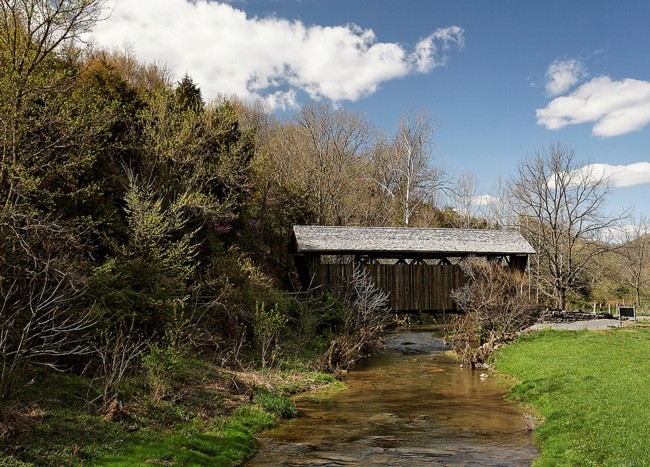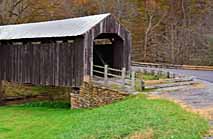|
Scenic USA - West Virginia The Covered Bridge Trail |

| Photo by Amanda Haddox Amanda Haddox Photography Inset photos by Ben Prepelka |
Long before there were highways, the Seneca Trail was pathway that followed a general north-south direction in today's eastern United States. First described as a boundary for early American settlers during the mid 1700s, the Seneca Trail was a major thoroughfare for the Iroquois Confederation. Named  for the Seneca Indian Tribe, the trail began in western New York State and followed river valleys when possible and continued southward toward the Carolinas and Georgia. Sometimes called a warpath and also a trading path, U.S. Route 219 generally follows the old Seneca Trail in West Virginia. It's along this route that covered bridge fans are able to travel the Covered Bridge Trail.
for the Seneca Indian Tribe, the trail began in western New York State and followed river valleys when possible and continued southward toward the Carolinas and Georgia. Sometimes called a warpath and also a trading path, U.S. Route 219 generally follows the old Seneca Trail in West Virginia. It's along this route that covered bridge fans are able to travel the Covered Bridge Trail.
Since the 1950s, West Virginia’s count of historic covered bridges has slowly dwindled. Falling from a count of at least 50 of these classic wooden structures, today’s remaining 17 bridges are all accounted for on the National Register of Historic Places. And here, just south of Hillsboro, covered bridge fans are able to begin their journey to five of these historic structures. The Covered Bridge Trail begins with the Locust Creek Covered Bridge. Placed in one of the most remote locations of all of the covered bridges in West Virginia, the 114 foot Locust Creek Covered Bridge was restored as a pedestrian bridge after it was bypassed in 1990.
Traveling south the next bridge, one of the oldest covered bridges in West Virginia is located south of interstate I-64. Built in 1884, the 54 foot Herns Mill Covered Bridge provided access to Hern's Mill. Built using a queenpost truss, the bridge still carries the traffic over Milligan Creek. Southward passed the city of Roncerverte,  the Hokes Mill Covered Bridge dates back to the late 1800s. The 82 foot bridge carries vehicular traffic over Second Creek.
the Hokes Mill Covered Bridge dates back to the late 1800s. The 82 foot bridge carries vehicular traffic over Second Creek.
Continuing southward, the two remaining bridges, Laurel Creek and Indian Creek bridges, complete the covered bridge tour. These two are close together and were restored in 2000. The Laurel Creek Covered Bridge, West Virginia’s shortest, is just under 25 feet long and still carries traffic near Lillydale. The Indian Creek Bridge, bypassed today, offers a unique story of its construction. Built near the town of Union, two teenagers, ages 16 and 18, managed to build the entire 49 foot span for a price of 400 dollars. Using a modified Howe truss, Oscar and Ray Weikel complete the task in a little over a year.
Especially scenic during the autumn season, this route offers a long line of historic attractions and beautiful state parks. While the Bridge Tour route takes only a few hours to drive, sightseers should make plans to enjoy this area as a multi-day experience.
Area Map
WV Seneca Trail Map

|
Nearby Points of Interest |
|
Copyright © 2022 Benjamin Prepelka
All Rights Reserved
